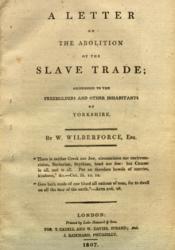Slave Trade Act
When Mr. Rochester arrives in Thornfield the estimated date is January of 1808, nearly one year after the Slave Trade Act “made it illegal to engage in the slave trade throughout the British colonies†(Abolition). The Rochester's, like most other wealthy white families at the time, came into wealth on the backs of slaves. On March 25th, 1807 the Slave Trade Act went into effect, but trading continued illegally until 1811. With slavery still heavily prevalent, Brontë alludes to it throughout the text. Jane was surprised by the warm welcome she received from Mrs. Fairfax, she had expected “only coldness and stiffness: this [was] not like what [she had] heard of the treatment of governesses†(Brontë ch.11). Jane associated the treatment of all ‘help’ with that of slaves—they were thought of as lowly and spoken down to. Earlier Jane calls her cousin, Jack, a “slave-driver†and describes how her cousins are abusive, exclusive, and lack compassion (Brontë ch. 1). Both instances make it apparent that slavery was a prominent aspect of life at the time and therefore a common association to make.
Sue Thomas analyzed the relationship between Christianity and the Slave Trade Act in regard to Jane’s character development and proposed the idea that “Jane’s growth of religious feeling […] is […] grounded in her consciousness of the tensions between slavery and Christianity†(Thomas 57). With the introduction of Mr. Rochester and the development of his and Jane’s relationship, Jane picks up on characteristics that would be expected of a slave master—in fact, Leah addresses Mr. Rochester as “Master†upon his arrival (Brontë ch.12). While they are getting to know each other in chapters 13-15, Jane is exposed to his true personality and the terms associated with slavery are used less frequently. Perhaps this was a conscious decision Brontë made to present the societal expectations of Mr. Rochester and contrast them with his true character, or Jane’s perception of his true character that is. There are several references to the supernatural and religion throughout these chapters as well—increasing as their interactions continue—this ties into Thomas’ theory of the tug of war Jane was experiencing between religion and slavery. It is to be expected that this allusion to slavery will continue to be a major underlying component of the story considering its historical relevance at the time.
“Abolition of the Slave Trade†The National Archives, 1 Aug. 1836,
https://www.nationalarchives.gov.uk/pathways/blackhistory/rights/abolition.htm#:~:text= Abolition%20of%20the%20Slave%20Trade%20Act%2C%201807&text=On%2 025%20March%201807%2C%20the,continued%2C%20regardless%2C%20until % 201811. Accessed 8 Jun. 2022.
Thomas, Sue. “Christianity and the State of Slavery in ‘Jane Eyre.’†Victorian Literature and Culture, vol. 35, no. 1, 2007, pp. 57–79. JSTOR, http://www.jstor.org/stable/40347124. Accessed 8 Jun. 2022.

